The Future of the Social Media Release is in Your Hands

This post was developed jointly by Todd Defren and Brian Solis.
The Social Media Release (SMR) is gaining traction and visibility and is now looked to by many as the savior of the traditional press release - which may honestly be too great a task for any one tool. But, at the very least, the discussions around the SMR are fueling the evolution and improvement of the press release overall.
Each day new examples are emerging and will only continue to be showcased as Social Media purveyors blaze the trail for the future of the news release, whether it’s traditional, multimedia, social or a combination of all the above.
As Social Media evolves, so does the process of discovery, sharing, and influence.
Traditional press releases distributed over wire services, for better or worse, ARE already showing up in search engines as a natural part of the wire distribution process.
According to Outsell, Inc. over 51% of IT professionals are reporting that they get their news from press releases in Yahoo and Google news over trade journals.
It's a fact that is changing the game for PR, and it's not only being driven by journalists, but customers too.
What it really represents is an opportunity, dictated by necessity, to do things better. And, in order to do that, we need to understand the dynamics of traditional, multimedia, and social media.
As a quick refresher, the Social Media Release template from SHIFT Communications was created in response to Tom Foremski’s public call for the death of press releases. The template provided, for the first time, a one-stop resource for bloggers, journalists, and people, to find relevant information for constructing stories without the B.S., or as Foremski called it, the “spintastic” messaging prevalent in traditional press releases.
The evolution of the Social Media Release in the 18 months since the SHIFT template’s debut is simply unbelievable and testament to the cumulative desire to carry the PR profession forward, in entirely new and exciting directions.
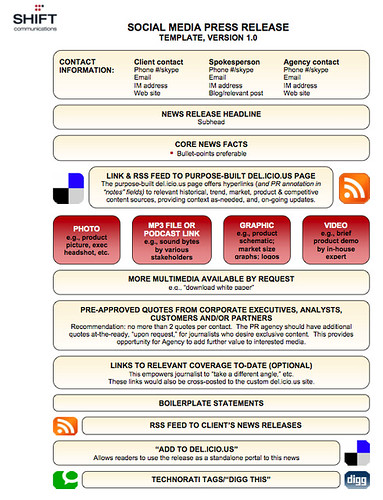
After working together along with Chris Heuer, Shel Holtz, Shannon Whitley, among many others, it’s clear that there is a hunger to evolve the 100-year old press release format, and in the process, maybe also improve the game for PR overall. Now it’s up to all of us to define. And since the world is watching, it’s important for us to occasionally take a step back in order to to carry SMRs forward.
In the last year, we have worked diligently to defend, explain, and showcase SMRs, but there are still many questions as word of a new format spreads. (For example: “What’s the difference between a SMR and a Multimedia Release? Should we put out a SMR in tandem with a traditional release? Can I rely on these releases to do my job for me?”)

So far the examples that we’ve highlighted over the past year – whether they’ve been distributed on a wire or hosted on a Web page – have all been a step in the right direction, but at the end of the day, with few exceptions, they are not quite fully “socialized” yet. They are representative of a hybrid multimedia and social media release, which can be distributed as traditional releases as well as simply hosted on traditional web pages. (Here's an example of a release that looks social, but isn’t quite there yet.)
Social Media Releases may look similar to today’s multimedia releases in format, structure and design, but depending on a series of factors, they have the ability to open up dialog in a way not possible with traditional or multimedia releases.
An important distinction between the two, discovered after spending the last year experimenting with formats and distribution channels, is this: the content and structure of the SMR is only part of the equation.
It all starts with thinking about what you want to say and figure out why it's important to those you want to reach.
A crappy press release is still a crappy press release regardless of multimedia or social bling.
Writing the news in a way that's helpful, informative, and relative is a critical starting point for any release.
SMRs are much more than bulleted text and links to multimedia content in social networks. It’s much more than simply sharing information. And, it’s definitely much more than providing building blocks in a “B.S.” free format. SMRs are a starting point for the socialization of news. We’ve got the multimedia part down: now we need to focus on the social aspects.
A big part of this socialization starts with “findability,” i.e. is the SMR discoverable outside in the world of Social Media?

Did you know that the major wire services used to be subscription-only?
Their 3,000+ daily releases were not open to the general public until recently. But the wires’ newfound openness means that traditional news releases can be discovered via Google and Yahoo. And search engines are an incredible catalyst for news distribution: people are finding news through Google and Yahoo and as a result have become more accepting of press releases as legitimate information resources, on a par with trusted trade journals (this has been documented by several analysts tracking the media space). After finding information through traditional search engines, people can still “socialize the content” by taking the initiative to manually bring it into the conversation, embedding links and content into their own blogs, del.icio.us accounts, etc.
This means that press releases, regardless of format, are now equally important to bloggers, journalists, analysts, and now, customers too!
Contrary to popular belief, however, search engines are not all created equal – especially in the world of Social Media.
For example, you probably didn’t know this: traditional & multimedia releases – which would include most of the SMRs released to-date – are not readily discoverable by “social” search engines like Technorati, not even if you use Technorati tags. The T’rati tags included in most SMRs will lead the reader to contextual links (if they exist), but, the release itself will remain invisible to the social search engine. Please keep in mind that this is different that the “suggested” tags that you’re seeing in the hybrid examples out there today. If anything, they just help increase findability in traditional search.

To be “seen” by these blog-specific engines requires a separate social media optimization (SMO) aka blog search engine optimization (BSEO) process and an entirely different distribution mechanism: if the SMR is not published via a social platform (note: blogs are inherently social) like Wordpress or Blogger, it’s going to be ignored by Technorati, BlogPulse, Google Blog Search, et al. So the SMRs we’ve seen so far have rarely been part of the broader, contextual conversation.

Shannon Whitley, current chair of the Social Media Release Working Group, which is dedicated to creating technology standards for creating and distributing SMRs, offered this insight:
“The best place to publish a Social Media News Release is on your company blog or social media newsroom (which is hosted on a blogging engine). However, it's important to recognize that Search Engine Optimization (SEO) alone will not necessarily draw attention to your news. It's still important to actively promote and distribute your releases via newswires and social media tools, and – wherever you promote your news – to provide a link back to your Social Media News Release.”This is an important point because if you’re relying on one release to reach everyone, the truth is that Social Media and multimedia releases can look exactly alike, but, they will show up in two different places.
So how do we get more “social” with our Social Media Releases?
Social can be defined as:
Hosting conversations – via moderated comments – directly at the hub of the SMR (ideally in the corporate social media newsroom) or providing a link to comments.At the end of the day, the SMR was never intended to replace the traditional press release nor is it supposed to relieve you of good ol’ media and blogger relations. In fact, experience thus far shows that SMRs are much stronger when paired with both a traditional counterpart and strategic outreach.
Providing a trackback function – and displaying the results. This is not only a good metric for marketers evaluating industry response, but also helpful to those looking for additional perspectives on the news.
Enabling links to social bookmarking sites (like del.icio.us) is good. So is the creation of purpose-built links that highlight other voices and provide context for the news.
Using links and tags that drive all of the images, video, and audio posted to social networks back to the SMR. These links and tags act as beacons for the conversation. It shouldn’t matter whether users come across a traditional, multimedia or social media release; it shouldn’t even matter if they find a “chunk” of the release’s content somewhere else on the web… by including relevant tags and by consistently associating the SMR’s dispersed content elements (on YouTube, Flickr, etc.) with the SMR’s permalink in the Social Media Newsroom, you can leave breadcrumbs that ultimately aggregate the resulting conversations in one convenient spot.

An SMR written in either bulleted or narrative format, partnered with a “static” release – each containing reciprocal links – can not only distribute meaningful news, but also offer building blocks (shareable content); facilitate and encourage conversations and sharing (via social media tags); and ensure a presence in both blog and traditional Web search engines (via SEO and SMO).
Multiple releases can specifically appeal to different groups using the channels the reach them (customers, bloggers, journalists, etc.). It will, for the first time, combine mainstream PR while creating new arms and legs to reach important groups that comprise The Long Tail.
The key to the SMR’s long-term success will be the ability to truly be social; to not only deliver the news in a snazzy new format, but also to facilitate discovery through Social Media channels, encourage sharing and spark conversations, all in a way that brings customers, journalists, bloggers, and analysts together around your story and your community.
The reason for this post is to remind people that tricking out press releases for the sake of tapping into a trend doesn't do anyone any good.
Writing the news in a way that's helpful, informative, and relative is a critical starting point for any release to be successful now and in the future.
Garbage in, garbage out.
The SMR template is a starting point to incite creativity and innovation. How you develop and issue SMRs is ultimately up to you, and given that these are the early days, the interest level is high in making sure we get this right. We’re all in this together.
This is a call to action for PR people to stop and think about the entire process and take the challenge for improvement, whether multimedia or social.
We have a responsibility to journalists, bloggers, analysts and to our customers that we need to finally take seriously. And, in order to build/continue relationships, we have to provide information in way that works for the different groups of people that want info, without the usual b.s. or spintastic hype.
For additional background, please read Everything You Wanted to Know About Social Media Releases.
Connect on Twitter, Jaiku, Pownce or Facebook.
blogger blog blogger+relations relations media press communications marketing marketing+2.0 pr2.0 pr+2.0 pr publicrelations public+relations media2.0 media+2.0 publicity todd+defren brian+solis press+release pressrelease news+release news social+media social socialmedia smr smpr hrelease multimedia digg delicious del.icio.us bookmark rss social+media+release social+media+press+release social+media+news+release social+network smo seo sem search bseo search+engine technorati flickr youtube key+words


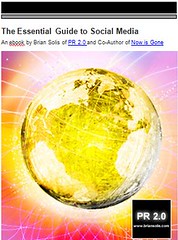

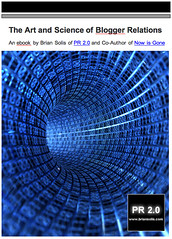
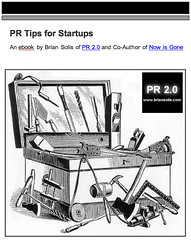
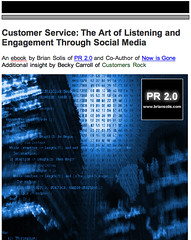





4 Comments:
And, I still think that we have more traction by teaching people how to write, and discouraging clients from sending out press releases all the time.
Nice to see this discussion continue and become more richer and inclusive. Searching for the perfect formula is important. Just as important as it is for testing out existing multimedia news releases, smart releases and other variations of the standard words-only press releases. Seems many still want a press release to be a trumpeted announcement. Maybe they aren't ready to use press releases as tool for back and forth discussion. Or maybe they're still not convinced that having open conversations are worth the (imagined) time and effort of the PR team. There are many different takes, but these efforts you guys have been working hard on...are helping many to try new things. Even if it's like taking baby steps (bullets and links) or giant leaps toward turning the press release into a living conversation vehicle. Kudos!!
I'm looking for a case study or example on how you guys are pushing your SMR's - I'm figuring a normal press release pointing to an SMR?
That's kinda middlemaning though?
I cross posted this comment at Todd's site.
I have long been a fan of doing something about the state of the press release, so I really appreciate that you have done that here.
My only tweak is that the SNR should not the be the end point for the conversation, but rather the facilitator of it. More people are becoming content creators and the SMR should facilitate that, and allow for the conversation to break out across the social media universe. Why drive everyone "back to the SNR" for a conversation. Instead let's work on better tracking tools and then go wherever the conversation springs up, a modern day version of the door-to-door political campaign.
The SMR could also point to a corporate blog or social forum for those who care about a conversational entry point with the company, but why on the SMR itself? Geoff and I address this in our post today, I made the link go directly to it (for some reason trackbacks weren't working)
Post a Comment
<< Home